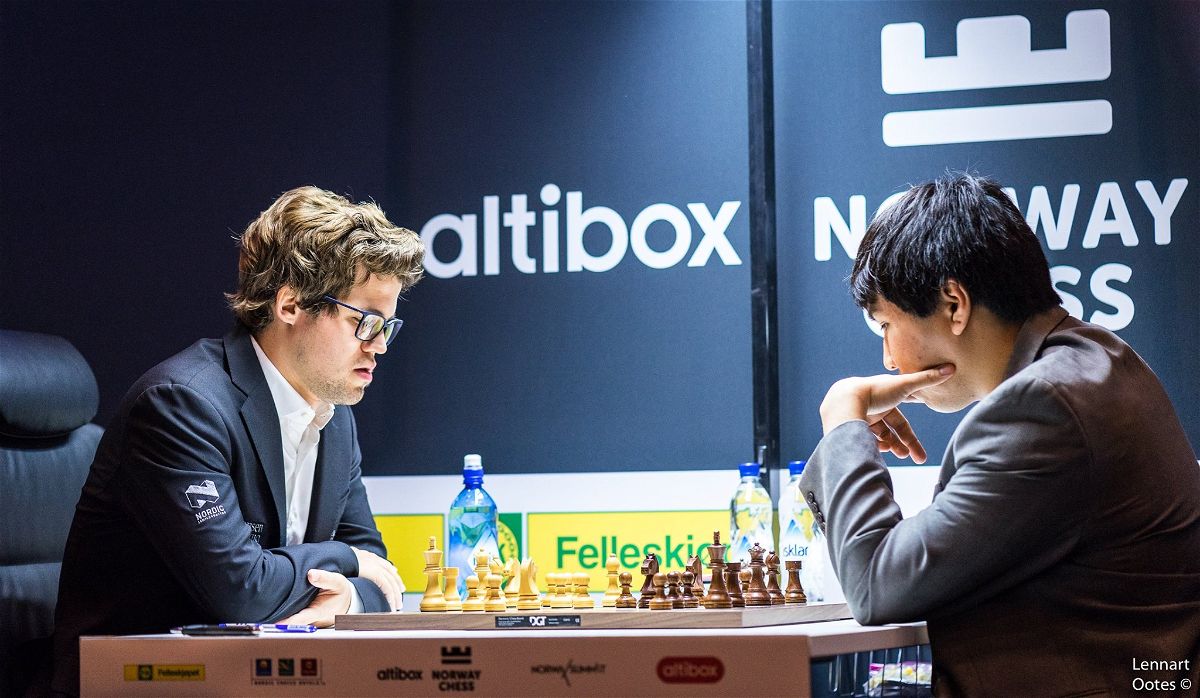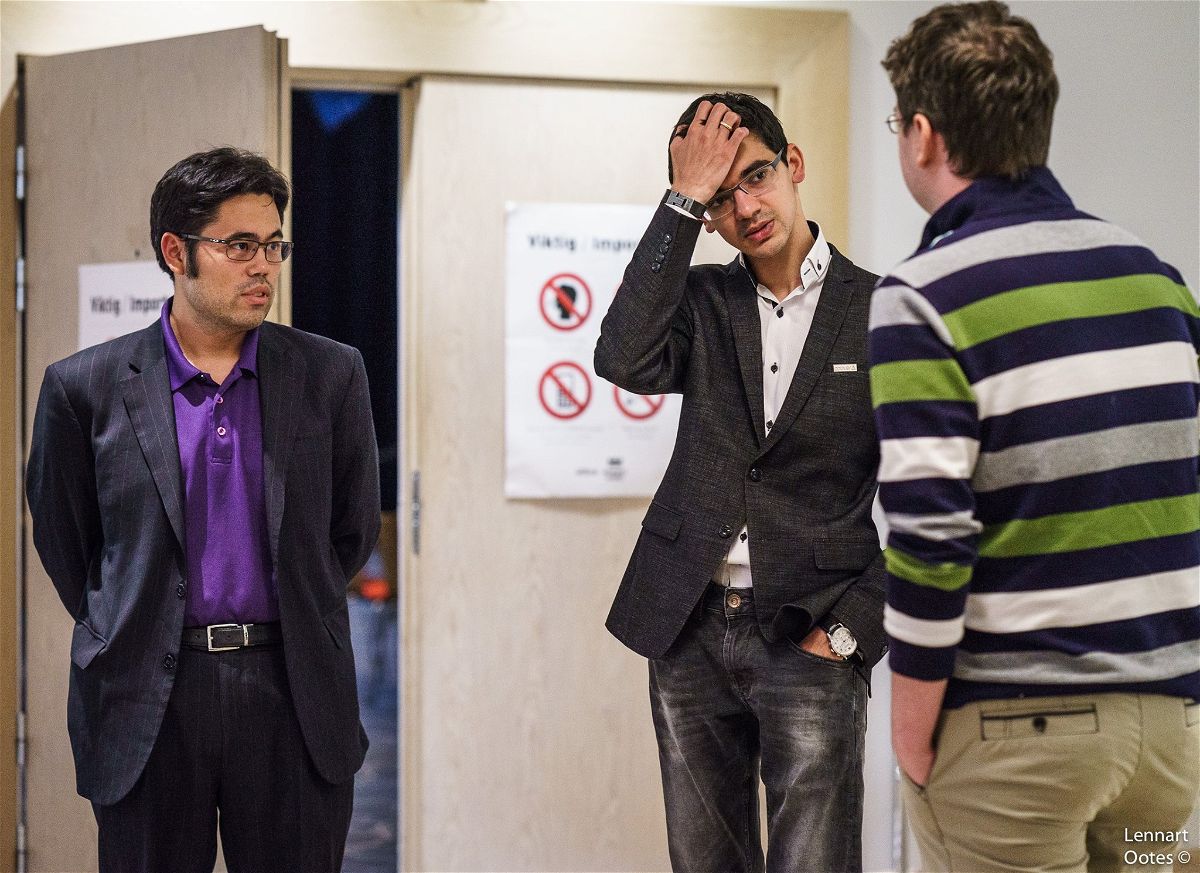Norway R01: Nakamura beats Giri; Anand draws against MVL
The strongest tournament of the year Altibox Norway Chess 2017 kicked off on Tuesday. Some call it like the Candidates, maybe even better, because we not only have the eight of the top ten players in the field, but also the World Champion is a part of the show. Out of the five games we had only one decisive result where Hikaru Nakamura defeated Anish Giri. Vishy Anand played the risky 3...c5 in Advance Caro Kann and drew the game without too many difficulties against MVL. We have detailed analysis of both these encounters.
Photos by Lennart Ootes

Featuring eight out of the top ten players in the world, the Altibox Norway Chess is indeed a spectacle. Among the participants are big names such as the current World Champion, Magnus Carlsen; his former challenger Sergey Karjakin; and world no. 2, Wesley So, who is considered by many to be the biggest threat to Carlsen. The only Indian at the event is our beloved Grandmaster, Viswanathan Anand. The tournament is a 10-player round robin event and is being held in the Norwegian city of Stavanger.
Round one began with some exciting match-ups. The tiger from Madras, Vishy Anand, was playing against the French number one, Maxime Vachier-Lagrave; World Champion, Magnus Carlsen was paired his arch-rival, Wesley So; Vladimir Kramnik was pitted against his countryman Sergey Karjakin; Lev Aronian was to cross swords with Fabiano Caruana; while Hikaru Nakamura was to play the Dutch number one, Anish Giri. Also, to add thrill to the encounters, Sofia rule has been applied. This means that the players are not allowed to talk to one another during the rounds and therefore could not offer draws at any point during the game.
| Round 1: June 6, 2017 in Clarion Hotel Energy | ||
| Hikaru Nakamura |
1-0
|
Anish Giri |
| Levon Aronian |
½-½
|
Fabiano Caruana |
| Magnus Carlsen |
½-½
|
Wesley So |
| M. Vachier-Lagrave |
½-½
|
Vishy Anand |
| Vladimir Kramnik |
½-½
|
Sergey Karjakin |
But despite all the efforts of the organisers to limit the number of draws in the event, four out of the five games were drawn in the first round. Vishy Anand kicked off his game with an off-beat line of the Caro-Kann defense moving his queen-bishop pawn twice, on moves 1 and 3. The Frenchman, however, did not hesitate to drift the game into a slightly double edged middle-game where he gave himself a weak pawn on c3 in order to gain activity. After the game Maxime said that he felt he was better throughout the game but wasn’t able to prove it. And although the game looked placid on the outset, a lot of complications loomed around in the background which the players chose to side-step.
[Site "Stavanger NOR"]
[Date "2017.06.06"]
[Round "1.1"]
[White "Vachier-Lagrave, Maxime"]
[Black "Anand, Viswanathan"]
[Result "1/2-1/2"]
[ECO "B12"]
[WhiteElo "2796"]
[BlackElo "2786"]
[Annotator "Sagar Shah"]
[PlyCount "87"]
[EventDate "2017.06.06"]
defeated MVL at the Leuven rapid. So why not again?!} 2. d4 d5 3. e5 c5 $5 {
Risky stuff. Usually 3...Bf5 is considered to be normal. But here Black goes
for something much combative.} 4. Ne2 (4. dxc5 {is the main move.}) 4... Nc6 5.
c3 Bg4 6. h3 (6. f3 {is what people usually play.}) 6... Bxe2 7. Bxe2 e6 {
I would already feel that Black is comfotable. He has exchanged his
problematic bishop in the French and has a clear cut plan of development for
his remaining guys. The knight could go from e7 or h6 to f5, bishop to e7
followed by 0-0. The queen can come to b6 and put pressure on d4. All that
being said, White has the bishop pair and also more space. So we can say he is
slightly better.} 8. O-O Qb6 {The pressure on the d4 pawn forces White to
release the tension.} 9. dxc5 Bxc5 10. b4 Be7 11. Be3 Qc7 {It's true that
White's pawn structure is not the best, but he has free flowing development.
It's always a trade off between more than one advantage.} 12. f4 Nh6 13. Na3 (
13. g4 {Stopping Nf5, but seems to weakening.} O-O 14. Nd2 f6 $1 15. exf6 Bxf6
$13 16. g5 Nf5 $1) 13... a6 14. Bd3 O-O 15. Nc2 f6 $1 {At the right moment
Black breaks in the centre and equalizes the position. This is extremely
important, because if White is able to get a grip on the position with Nd4, it
would be very difficult for Black to wriggle out.} 16. Nd4 (16. exf6 Bxf6 $11)
16... Nxd4 $1 (16... Qd7 $6 17. Qc2 $1 fxe5 18. Bxh7+ Kh8 19. Nxc6 bxc6 20.
fxe5 $16) 17. Bxd4 (17. cxd4 Bxb4 18. Rc1 Qe7 {White has some compensation but
nothing special.}) 17... fxe5 18. Bxe5 Bd6 19. Bxd6 Qxd6 $11 {Black is
completely fine. The e6 weakness is compensated by the c3 weakness. The knight
will stand well on f5. In general Anand has nothing to worry.} 20. Qd2 Nf5 21.
Rae1 Rac8 22. Re5 Rf6 (22... g6 $11) 23. Rfe1 (23. Bxf5 Rxf5 24. Rxf5 exf5 25.
Re1 {White keeps a miniscule edge.}) 23... g6 24. Bxf5 gxf5 25. Qe3 Rc6 26. a4
Qc7 27. c4 $1 {A very strong pawn sacrifice by Maxime.} Rxc4 (27... dxc4 {
What exactly is the problem with this move?} 28. b5 $1 axb5 29. axb5 Rd6 30.
Rc5 Qd7 31. Qe5 Rg6 32. Rxc4 $16) 28. Rxe6 Re4 $1 29. Qg3+ Qg7 30. Re8+ Rf8 {
It's quite a funny position where all the pieces are aiming against each other.
In the next three moves, all three pairs of major pieces come off and the game
peters out into a drawn pawn endgame.} 31. Qxg7+ Kxg7 32. R1xe4 fxe4 (32...
dxe4 {was also enough for a draw.} 33. Rxf8 Kxf8 34. g4 Kf7 35. Kf2 Ke6 36. Ke3
b5 37. a5 Kf6 $11) 33. Rxf8 Kxf8 34. Kf2 d4 35. g4 Kf7 36. h4 h5 37. gxh5 Kf6
38. h6 Kg6 39. f5+ Kxh6 40. a5 Kh5 41. Ke2 Kh6 42. Kf2 Kh5 43. Ke2 Kh6 44. Kf2
{A fine counterattacking game by Anand. He didn't really have to struggle much
for the half point.} 1/2-1/2

This is a good result for Anand considering how effortlessly he was able to hold someone like Vachier Lagrave to a draw with the black pieces. It would be interesting to see how Anand fares with the white pieces in the next round. Given his choice of a slightly unorthodox opening with the black pieces, it is possible that he might uncork something even more surprising when he has white.

Wesley has shown an astounding form in the one year and to rise to the world number two spot. Many chess experts think that he can be the biggest threat to Carlsen given the prodigious quality of his game. But Magnus too showed that he is up for a fight. The organisers of Altibox had organized a blitz tournament before the main event began in order to allot numbers to players for the drawing of lots. The winner of the blitz tournament got to pick the number of his choice while the subsequently ranked players got the highest available number.
Magnus not only won the blitz tournament by beating Wesley in the last round but also chose the number that would pair him against Wesley in the inaugural round of the main event. But when the round began he chose the modest Italian opening which didn’t offer him much advantage. The game soon fizzled into a draw. The same opening as well as the same result was seen in the all-Russian clash between Vladimir Kramnik and Sergey Karjakin.
The Armenian superstar, Levon Aronian felt he had an edge throughout his game against Fabiano Caruana but wasn’t really able to convert it into a full point and had to settle with a draw.


The game between Hikaru Nakamura and Anish Giri was the only decisive game of the round. Anish chose to answer Hikaru’s 1. d4 with a relative sideline of the Grunfeld defence. Giri also sacrificed a pawn and had to liquidate into a slightly worse endgame to recover his pawn. However, his crucial mistake came on move 45 when Giri, with the black pieces played 45… Ke7. The rest was then a technical task which Naka accomplished successfully.
[Site "Stavanger"]
[Date "2017.06.06"]
[Round "1"]
[White "Nakamura, Hikaru"]
[Black "Giri, Anish"]
[Result "1-0"]
[ECO "D80"]
[WhiteElo "2785"]
[BlackElo "2771"]
[Annotator "Ramirez Alvarez,Alejandro"]
[PlyCount "133"]
[EventDate "2017.??.??"]
Qb1 b6 9. Nh3 Bh6 10. Bg5 Bxg5 11. Nxg5 Qd5 12. Nxe6 Qxe6 13. Qb4 Qd5 14. Qxc4
Qxc4 15. Bxc4 e6 16. Be2 Nd7 17. a4 Ke7 18. a5 c6 19. Kd2 b5 20. Rab1 Rab8 21.
Rb2 f5 22. Rhb1 Kd6 23. f3 e5 24. c4 exd4 25. cxb5 cxb5 26. Bxb5 dxe3+ 27. Kxe3
{Let us start looking at the game here. Before this, it was a Grunfeld and we
got to this position which, though perhaps almost equal, does hold a bit of
danger for Black. Bishops are superior to knights, and the kingside pawns will
be vulnerable to an attack by the light-squared diagonal user. This endgame is
a bit reminiscent of what Fischer called the "minor exchange".} Nf6 28. Bc4
Rxb2 (28... Rhe8+ 29. Kd4 Rbd8 $1 {Was the unnatural, but best way, to hold.
The point is that the rooks create an unsafe environment for the kings, which
makes it difficult for White to make progress.} 30. Rb7 Kc6+ 31. Kc3 Re3+ 32.
Kc2 Rd4 {for example}) 29. Rxb2 Re8+ 30. Kd4 {Notice how Black's knight is
uncomfortably controlled compared to White's bishop.} Re7 31. Rb8 Rd7 32. Rc8
Rb7 33. a6 $1 {Puttin in the squeeze. The rook can't stay on the seventh rank,
but there isn't enough time to create counterplay.} Rb4 (33... Re7 34. Bb5 {
and the surprising checkmate on c6 is not so easy to parry.}) 34. Kc3 Ra4 35.
Kb3 Nd7 36. Bb5 (36. Kxa4 Nb6+ 37. Kb5 Nxc8 38. Bg8 h6 {is no dangerous for
Black as there is no penetration square once the knight reaches e7}) 36... Ra5
37. Kb4 Ra1 38. Rd8 Rb1+ 39. Ka5 Ra1+ 40. Kb4 Rb1+ 41. Ka4 Ra1+ 42. Kb3 Rb1+
43. Kc4 Rc1+ 44. Kd3 Rc7 45. Kd4 {Black has stabilized from now, but he is far
from out of danger.} Ke7 46. Ra8 Kd6 47. h4 $1 {Now phase two, if you will:
White advances a bit on the kingside to creat threats} Ke7 $2 {An unfortunate
timing} (47... Nb6 48. Rh8 Ke6 49. Re8+ Kd6 50. h5 {is still very hard to hold}
) 48. Bxd7 $1 {Nakamura does not miss his chances. The rook endgame is
hopeless.} Rxd7+ (48... Kxd7 49. Kd5 Ke7 50. Rh8 Kf6 51. Kd6 {and everything
falls apart} Rc2 {! the only way to resist} 52. Rxh7 Rxg2 53. Rxa7) 49. Ke5 Kf7
50. Rb8 {This is the killing maneuver. Any rook trade is hopeless.} Re7+ 51.
Kd5 Kf6 52. Rb7 Re5+ 53. Kd4 Ra5 54. Rxa7 {This endgame is sometimes a draw,
but not in this csae, with a weak kingside and the pawn on the sixth and not
the seventh, as you will find out why soon!} f4 55. Kc4 Ra2 56. Kc5 h5 57. Ra8
Rc2+ 58. Kb6 Rb2+ 59. Kc5 Rc2+ 60. Kb6 Rb2+ 61. Ka7 Rxg2 62. Rb8 Rf2 63. Rb6+
Kg7 64. Kb7 Rxf3 65. a7 Ra3 66. Ra6 Rb3+ 67. Kc6 1-0

With his win in the very first round, Hikaru Nakamura has emerged as the sole leader after round 1. He is followed by 8 players including Vishy Anand who are tied at 0.5/1 while Anish Giri, with his loss, is at the bottom of the table. There are, however, eight more rounds to go and given the closely matched field, battles can be expected to be grueling.
About the author:

Aditya Pai is an ardent chess fan, avid reader, and a film lover. He has been an advertising copywriter and is currently pursuing a Master's in English Literature at the University of Mumbai. He loves all things German and is learning the language. He has also written scripts for experimental films.
